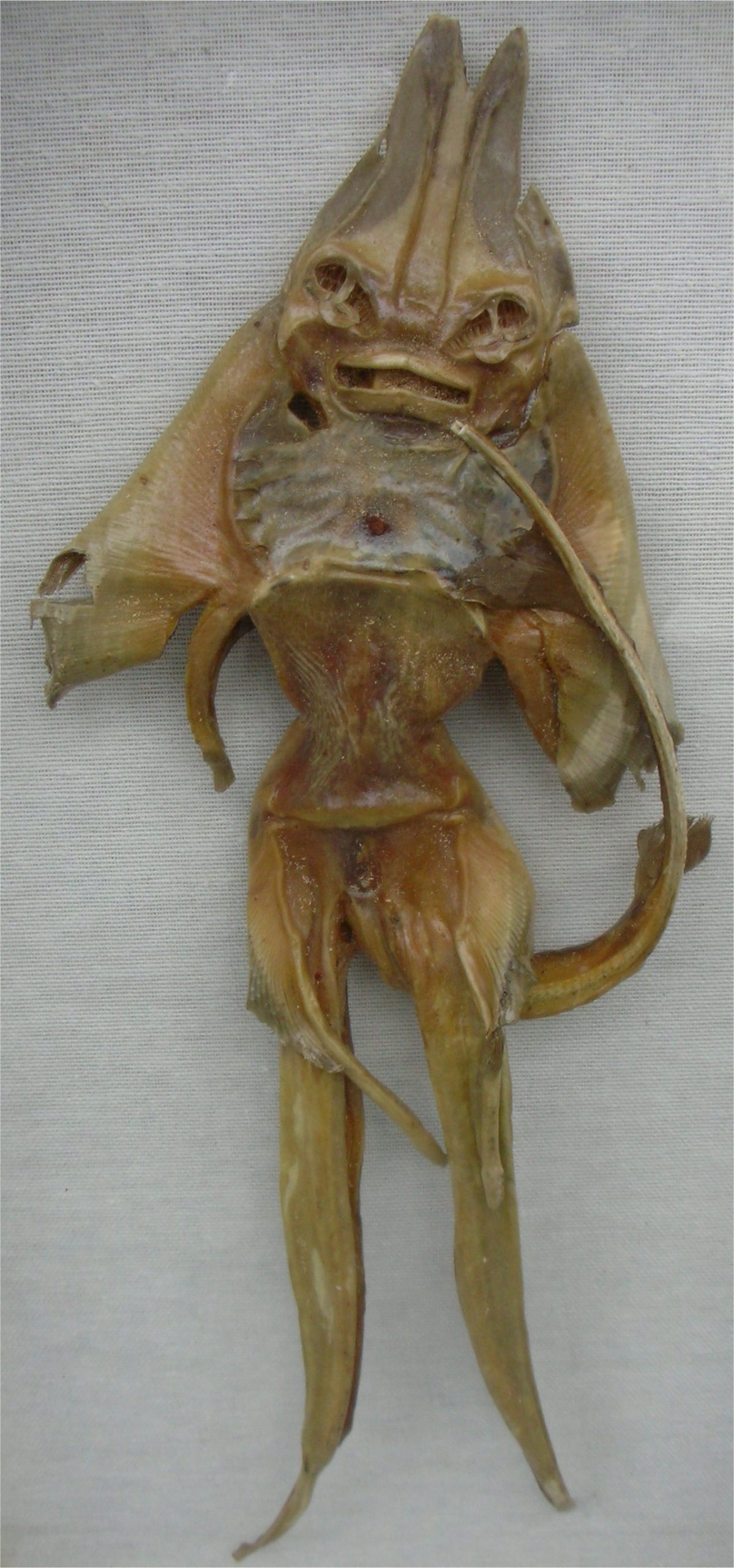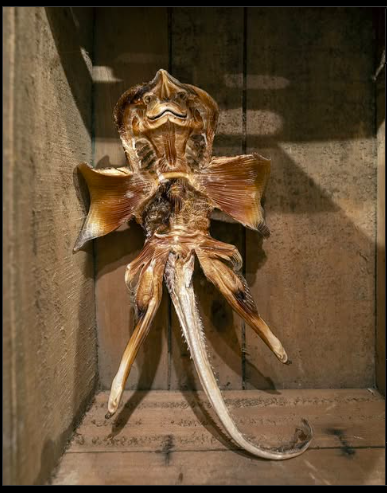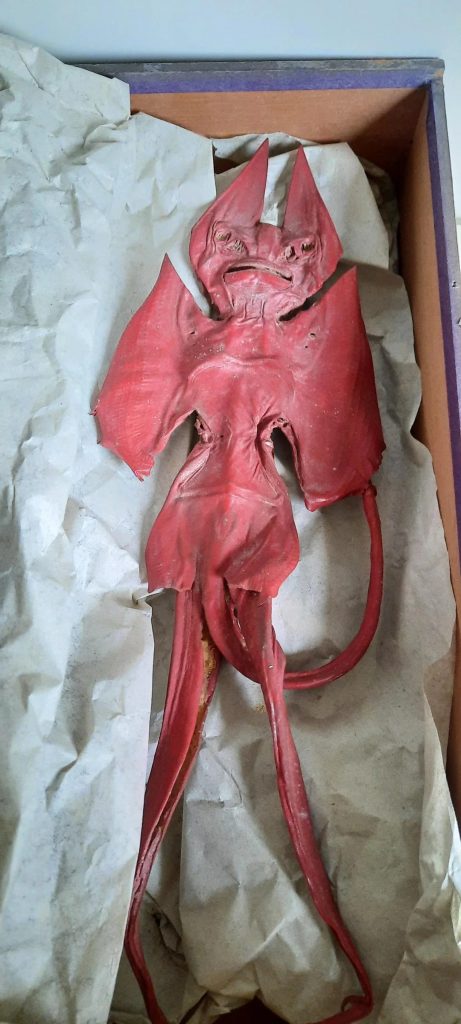Jenny Hanivers: The Mythical Creatures That Tricked Tourists for Centuries 🧜♀️🐟
In the 16th century, sailors plying the seas would often encounter strange creatures and mythical beasts in their travels, many of which were the stuff of legends. However, some of the most fascinating—yet deceptive—creatures were actually created by the sailors themselves. One of the most bizarre and enduring examples of these creations are the Jenny Hanivers, a type of “mermaid monster” or “devil fish” that was sold to unsuspecting tourists as proof of the fantastical creatures lurking beneath the ocean.

What is a Jenny Haniver?
A Jenny Haniver is a manipulated ray or skate fish, whose body is altered into the shape of a mythical creature through a process of preservation and artificial shaping. The fish, typically a ray or skate, is dried, and then its fins and other parts of its body are bent and manipulated to resemble a mermaid, monster, or devil fish. The result is an eerie, fantastical figure that appears to be a hybrid of fish and human-like features—usually with the body of a fish but with flippers or even “arms” that suggest the form of a mythical creature.
These “creatures” were often sold to tourists, particularly during the 16th and 17th centuries, when explorers and sailors would return from their voyages with strange objects and artifacts meant to amaze and mystify the public.
The Craft Behind the Jenny Haniver

The process of creating a Jenny Haniver was an art form—and a profitable business for sailors. The fish would typically be captured, often a ray or skate, which are cartilaginous fish that have wings or flaps. The sailors would then dry the fish in the sun or preserve it using salt. After that, they would manipulate the body, bending its fins and shaping it into something that resembled a mythical creature. In some cases, they would use tools to carve features like eyes or mouths into the fish to make it even more lifelike and creepy.
Some Jenny Hanivers were simply dried and sold as curiosities, while others were embellished with additional materials or modified further to appear more fantastical. They were then displayed as “sea monsters,” “devil fish,” or even “mermaids”—designed to capture the imagination of sailors and tourists alike.
Why Did Sailors Create Jenny Hanivers?
During the Age of Exploration, when Europeans were traveling to far-flung places and encountering new species and cultures, there was an increasing fascination with the mysterious and unknown. For sailors, who often faced long, lonely voyages, the creation of Jenny Hanivers was a way to make some extra money. By crafting these creatures and selling them as curiosities or exotic trophies, sailors could capitalize on the public’s interest in the supernatural and bizarre.
Sailors would sell these fish-turned-monsters to passing traders, tourists, or collectors. They became a popular souvenir or keepsake, particularly for those fascinated by sea lore and cryptozoology. These strange objects, some looking eerily human, others monstrous, were often passed off as evidence of sea creatures such as mermaids, devil fish, or even demonic sea gods.
The Myth and the Reality
Though the creatures were marketed as real, mysterious sea creatures, they were purely human-made hoaxes. However, this didn’t stop the public from being captivated by them. Jenny Hanivers often sparked curiosity, superstition, and fascination. They were believed to be part of the mythical world of the sea, a world filled with mermaids, monsters, and other creatures that only existed in the imagination—or, so sailors claimed.
As the centuries passed, Jenny Hanivers became less of a novelty but continued to hold a place in maritime folklore. By the 19th and 20th centuries, their creation became more of a curiosity or even a collector’s item rather than a profitable business for sailors. However, the practice has not entirely died out, with some artisans still crafting Jenny Hanivers to this day.
Jenny Hanivers in Modern Times
Although the practice of creating Jenny Hanivers is no longer widespread, these mythical creatures have become an enduring part of maritime history. They continue to appear in historical exhibits, collections, and occasionally in curiosity shops where they remain as oddities of the past.
Some modern collectors or artists still craft Jenny Hanivers, often as a form of art or tribute to the old traditions. While they are no longer sold as “real” sea monsters, they are sometimes created as artifacts, folk art, or even modern-day curiosities for those interested in strange, historical oddities.
The Enduring Allure of the Jenny Haniver
The story of the Jenny Haniver is a tale of craftsmanship, deception, and mythology—a reminder of how humanity has always been drawn to the strange and supernatural. These manipulated fish, sold as mermaids or devil fish, were more than just tricks for tourists—they were a part of the rich tapestry of maritime folklore and the Age of Exploration, when sailors, adventurers, and traders sought to thrill the imagination of the public with their exotic treasures.
Today, Jenny Hanivers stand as both a quirky piece of maritime history and a testament to the creativity (and sometimes deception) that has long shaped our understanding of the unknown. The next time you come across one, you’ll know it’s not a real sea monster—just a cleverly crafted reminder of a time when sailors crafted their own myths.

